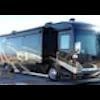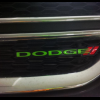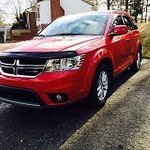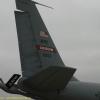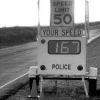-
Posts
282 -
Joined
-
Last visited
-
Days Won
15
Reputation Activity
-
 webslave got a reaction from SeanTacular in Connect additional LED light on head light switch
webslave got a reaction from SeanTacular in Connect additional LED light on head light switch
If you are talking about a "running light bar", similar to what is on the KIT2000 car (remember that TV show?), then I would get a simple 12 volt relay, splice the relay into the hot line for one of the headlights, hook the led bar to the output side and then draw the power from the fuse box or the battery. The relay won't draw enough current to affect the output of the headlight, but, it will switch the light bar on when the headlights have power. Some states frown on the use of "display lights" used in general driving and I don't know of any states that allow high power off-road light bars in general use that is why I'm assuming that you are talking about a "display light"...depending on your state you might be able to get away that (similar to the "ground effect" lights). I would still put an on/off switch in the power feed to the light bar, just in case.
-
 webslave got a reaction from jkeaton in Connect additional LED light on head light switch
webslave got a reaction from jkeaton in Connect additional LED light on head light switch
If you are talking about a "running light bar", similar to what is on the KIT2000 car (remember that TV show?), then I would get a simple 12 volt relay, splice the relay into the hot line for one of the headlights, hook the led bar to the output side and then draw the power from the fuse box or the battery. The relay won't draw enough current to affect the output of the headlight, but, it will switch the light bar on when the headlights have power. Some states frown on the use of "display lights" used in general driving and I don't know of any states that allow high power off-road light bars in general use that is why I'm assuming that you are talking about a "display light"...depending on your state you might be able to get away that (similar to the "ground effect" lights). I would still put an on/off switch in the power feed to the light bar, just in case.
-
 webslave got a reaction from priell3 in Front and Rear Splash Guards for 2012 AVP
webslave got a reaction from priell3 in Front and Rear Splash Guards for 2012 AVP
Well, the splash guards arrived and I got around to installing them today, sheesh 55 degrees outside in the middle of January while the southwest is freezing...
Perfect fit, front and rear on my '13 R/T. Took me a couple of hours, but, only about 45 minutes of real work, the rest of the time I was just "puttering" and "looking" at the mechanicals of the car.
Part number #82210996AB, for the front, fitting 2011-2013 Dodge Journeys were easiest to put on.
Part number #82212865, for the rear, fitting 2011-2013 Dodge Journeys were also easy, but, not as easy as the fronts. I finally gave up trying to get the clip nuts onto the wheel well shield and just used them as nuts for the screws. Easy to reach the screws from underneath and didn't require any swear words (I recently was diagnosed with RA and the fingers don't work like they used to, leading to lots of swearing as I adjust to my "new range {read lack} of mobility")!
So, for those of you that have a 2011-2013 Dodge Journey, those are the appropriate part numbers for the molded splash shields from Mopar. Perfect fit and they really look sharp. We use a lot of "anti-skid" cinders in our area and they should prevent the sandpaper effect of them being thrown against the undercarriage and rocker panels. I'll have to see if they have any effect on the spray kicked up onto the back of the Journey the next time it rains/snows. I doubt if it will make much of a difference, but, I can always hope!
-
 webslave got a reaction from ChiefH in 2013 Journey – Fuel tank size??
webslave got a reaction from ChiefH in 2013 Journey – Fuel tank size??
According to my manual for my 2013 AWD R/T; the fuel capacity is 21 gallons (FWD is only 20.5) and the "Low Fuel Light" is supposed to come on at ~3 gallons left. If I'm getting 21 mpg, that is, of course, 61 miles to empty. I just put fuel in the car today and it was just a hair under the 1/4 level and the EVIC reported that I had 101 miles to empty. I pumped 14.79 gallons. So I had (21-14.79=) 5.21 gallons remaining when I filled up. A quarter of a tank, based on 21 gallons, would be 5.25 gallons. My gauge seems to be fairly accurate and the EVIC is fairly accurate in its "prediction"; I got 21.3 mpg on that tankful and with 5.21 gallons left, I had about 110 miles to empty based on that tank's average, while the EVIC said I had 101 miles to empty. The disparity in the EVIC comes about because it uses "immediate" mpg data to calculate remaining range and I had just come through town with slower traffic and our one stop light which would have had a lower "immediate" mpg value.
All in all, my fuel system seems to be quite accurate... I can't remember the last time I ever had a "Low Fuel" warning come on in a car I've been driving. We live way out in the sticks and if you get down to 3 gallons in most of my area, you'll be walking before you get to a gas station; I usually keep at least 1/2 tank and start to get nervous at 1/4 (that "habit" comes from my usual low mileage vehicles; Hemi Commander won't get to town on a 1/4 tank), so, I doubt if I'll ever see the "light" come on...and based on my numbers, I'll accept the manual's 21 gallon total capacity and the fuel gauge's markings to be pretty reliable (5.25 gallons / quarter) and I'll just go on faith that if I ever do get down to ~3 gallons, I'll see the "light".
-
 webslave got a reaction from dhh3 in Does my journey have an alarm?
webslave got a reaction from dhh3 in Does my journey have an alarm?
From the User's Guide:
THEFT ALARM To Arm: • Press the Keyless Enter-N-Go™ Start/Stop button until the Electronic Vehicle Informa- tion Center (EVIC) indicates that the vehicle ignition is “OFF”. Press the power door lock switch while the door is open, press the Key Fob LOCK button, or with one of the Key Fobs located outside the vehicle and within 5 ft (1.5 m) of the driver's and passenger front door handles, press the Keyless Enter-N-Go™ LOCK button located on the door handle. NOTE: After pressing the Keyless Enter-N-Go™ LOCK button, you must wait two seconds before you can lock or unlock the vehicle via the door handle. To Disarm: • Press the Key Fob UNLOCK button or with one of the Key Fobs located outside the vehicle 12 and within 5 ft (1.5 m) of the driver's and passenger front door handles, grab the Keyless Enter-N-Go™ door handle and enter the vehicle, then press the Keyless Enter-N-Go™ Start/Stop button (requires at least one valid Key Fob in the vehicle). The alarm system will arm if you use the keypad on the armrest or the key fob/fobic. It will not arm if you have a key and use the door lock cylinder or if you manually push each door's lock plunger. IIRC, besides the lights flashing and horn blowing, that some models (high end) of the FMC (feels funny using that instead of MOPAR) line also included shifter locks and fuel pump interlocks; effectively disabling the car from being hotwired. I don't know which specific models included those features or, even if it is still valid, but, vaguely remember reading about it somewhere... -
 webslave got a reaction from OhareFred in Towing Feedback
webslave got a reaction from OhareFred in Towing Feedback
Along with the good information from jkeaton, I'll add that the DJ doesn't have the engine cooling or transmission cooling capacity required for any serious towing. The DJ's towing is aimed at a bicycle rack in the hitch or a small, open landscaping trailer. Before you rush out and buy an RV (travel trailer), even one within your DJ's weight limit, look up the frontal area restriction for your DJ. Regardless of the weight of the trailer, you will also find a "frontal area maximum" that is allowed. Frontal area and weight are the two biggest limiters for trailers. The ability to pull a large flat wall through the air at highway speeds demands much more from an engine / drive train, than does a smaller frontal area as found on popup RVs or utility trailers and boats. I've been RVing for quite a few years and the DJ is not a vehicle I would choose to pull an RV trailer.
-
 webslave got a reaction from dj cowboy in Towing Feedback
webslave got a reaction from dj cowboy in Towing Feedback
Along with the good information from jkeaton, I'll add that the DJ doesn't have the engine cooling or transmission cooling capacity required for any serious towing. The DJ's towing is aimed at a bicycle rack in the hitch or a small, open landscaping trailer. Before you rush out and buy an RV (travel trailer), even one within your DJ's weight limit, look up the frontal area restriction for your DJ. Regardless of the weight of the trailer, you will also find a "frontal area maximum" that is allowed. Frontal area and weight are the two biggest limiters for trailers. The ability to pull a large flat wall through the air at highway speeds demands much more from an engine / drive train, than does a smaller frontal area as found on popup RVs or utility trailers and boats. I've been RVing for quite a few years and the DJ is not a vehicle I would choose to pull an RV trailer.
-
 webslave got a reaction from dhh3 in 2010 Journey Passenger Grab Handle (bar)
webslave got a reaction from dhh3 in 2010 Journey Passenger Grab Handle (bar)
Mine has the grab handles above the door also. I find them mostly useless for aiding getting in or out of the car. We (DW and I) are short, so the seats are forward. The grab handles wind up above and behind our heads providing no leverage for getting in or out. What ever happened to the "tried and true" A pillar handles? Wish they'd put them back in the vehicles...they were good for gaining leverage and stability and made good "panic" grips in those "sporty" situations where the passenger goes "white knuckle" with the excitement
-
 webslave got a reaction from onecrazyfoo4u in Towing Feedback
webslave got a reaction from onecrazyfoo4u in Towing Feedback
Along with the good information from jkeaton, I'll add that the DJ doesn't have the engine cooling or transmission cooling capacity required for any serious towing. The DJ's towing is aimed at a bicycle rack in the hitch or a small, open landscaping trailer. Before you rush out and buy an RV (travel trailer), even one within your DJ's weight limit, look up the frontal area restriction for your DJ. Regardless of the weight of the trailer, you will also find a "frontal area maximum" that is allowed. Frontal area and weight are the two biggest limiters for trailers. The ability to pull a large flat wall through the air at highway speeds demands much more from an engine / drive train, than does a smaller frontal area as found on popup RVs or utility trailers and boats. I've been RVing for quite a few years and the DJ is not a vehicle I would choose to pull an RV trailer.
-
 webslave got a reaction from 2late4u in 2010 Journey Passenger Grab Handle (bar)
webslave got a reaction from 2late4u in 2010 Journey Passenger Grab Handle (bar)
Mine has the grab handles above the door also. I find them mostly useless for aiding getting in or out of the car. We (DW and I) are short, so the seats are forward. The grab handles wind up above and behind our heads providing no leverage for getting in or out. What ever happened to the "tried and true" A pillar handles? Wish they'd put them back in the vehicles...they were good for gaining leverage and stability and made good "panic" grips in those "sporty" situations where the passenger goes "white knuckle" with the excitement
-
 webslave got a reaction from rolly in Towing Feedback
webslave got a reaction from rolly in Towing Feedback
Along with the good information from jkeaton, I'll add that the DJ doesn't have the engine cooling or transmission cooling capacity required for any serious towing. The DJ's towing is aimed at a bicycle rack in the hitch or a small, open landscaping trailer. Before you rush out and buy an RV (travel trailer), even one within your DJ's weight limit, look up the frontal area restriction for your DJ. Regardless of the weight of the trailer, you will also find a "frontal area maximum" that is allowed. Frontal area and weight are the two biggest limiters for trailers. The ability to pull a large flat wall through the air at highway speeds demands much more from an engine / drive train, than does a smaller frontal area as found on popup RVs or utility trailers and boats. I've been RVing for quite a few years and the DJ is not a vehicle I would choose to pull an RV trailer.
-
 webslave got a reaction from dhh3 in Towing Feedback
webslave got a reaction from dhh3 in Towing Feedback
Along with the good information from jkeaton, I'll add that the DJ doesn't have the engine cooling or transmission cooling capacity required for any serious towing. The DJ's towing is aimed at a bicycle rack in the hitch or a small, open landscaping trailer. Before you rush out and buy an RV (travel trailer), even one within your DJ's weight limit, look up the frontal area restriction for your DJ. Regardless of the weight of the trailer, you will also find a "frontal area maximum" that is allowed. Frontal area and weight are the two biggest limiters for trailers. The ability to pull a large flat wall through the air at highway speeds demands much more from an engine / drive train, than does a smaller frontal area as found on popup RVs or utility trailers and boats. I've been RVing for quite a few years and the DJ is not a vehicle I would choose to pull an RV trailer.
-
 webslave got a reaction from jkeaton in Towing Feedback
webslave got a reaction from jkeaton in Towing Feedback
Along with the good information from jkeaton, I'll add that the DJ doesn't have the engine cooling or transmission cooling capacity required for any serious towing. The DJ's towing is aimed at a bicycle rack in the hitch or a small, open landscaping trailer. Before you rush out and buy an RV (travel trailer), even one within your DJ's weight limit, look up the frontal area restriction for your DJ. Regardless of the weight of the trailer, you will also find a "frontal area maximum" that is allowed. Frontal area and weight are the two biggest limiters for trailers. The ability to pull a large flat wall through the air at highway speeds demands much more from an engine / drive train, than does a smaller frontal area as found on popup RVs or utility trailers and boats. I've been RVing for quite a few years and the DJ is not a vehicle I would choose to pull an RV trailer.
-
 webslave got a reaction from dhh3 in 2014 journey blown transmission
webslave got a reaction from dhh3 in 2014 journey blown transmission
Yep... Blew the PCM in my brand new Trailhawk 3 days ago... Wouldn't shift out of park and when I used the over-ride, no throttle response. Those computers that enable the "fly by wire" systems have their hooks into everything.
-
 webslave got a reaction from jkeaton in 2014 journey blown transmission
webslave got a reaction from jkeaton in 2014 journey blown transmission
Yep... Blew the PCM in my brand new Trailhawk 3 days ago... Wouldn't shift out of park and when I used the over-ride, no throttle response. Those computers that enable the "fly by wire" systems have their hooks into everything.
-
 webslave got a reaction from dhh3 in 2014 Journey, which antenna's are where?
webslave got a reaction from dhh3 in 2014 Journey, which antenna's are where?
It is still "early" in the model year for 2014. A dealership has access to the parts listings, but, by and large, most others don't as it is awful early for parts replacement that wouldn't be covered a warranty. Since warranties cover the parts, most places don't bother stocking or listing those parts until the warranty period is winding down, or they feel the demand for the "add-on" market warrants the expense and website updates. It isn't cheap to handle those listings, even the web sites need to be altered to handle the additional data and display and that requires new coding and testing to verify functionality.
-
 webslave got a reaction from dhh3 in 2014 Journey, which antenna's are where?
webslave got a reaction from dhh3 in 2014 Journey, which antenna's are where?
The truck has a speed sensitive variable wiper setup - the faster you go, the faster the variable sweep is, but, on the Jeep, the sensor actually activated the wipers, just like the automatic headlights do (it gets dark and the lights come on; again a little sensitive for my tastes, but, not as annoying as the wipers). If it misted, or thought it did, even if it was a mist from the car ahead of you running their windshield cleaner and the mist floated back to your car, the windshield wiper would start, smear the windshield and then stop...then, I'd have to clean my windshield so that I could see through it. Like I said, I disabled it. The automatic headlights are also a bit sensitive. I live out in the woods...late afternoon, if I go under a bunch of trees, the headlights come on (the Jeep, the Ram and the DJ) and then when I get out from under the overhang, they go back off, then under some more trees and they come back on. I'm sure it is annoying if I happen to following someone..."what's that fool back there doing, lights on, lights off, lights on...you get the idea, but, the auto windshield wipers were a nightmare. The speed sensitive variable wiper is just fine though.
-
 webslave got a reaction from dhh3 in 2014 Journey, which antenna's are where?
webslave got a reaction from dhh3 in 2014 Journey, which antenna's are where?
I started to suggest the rain sensor idea, but, thought that MOPAR had gotten away from that, at least, that design. I had a box very similar to that in my '08 Jeep Hemi Commander Limited. Like my '13 DJ R/T, it was loaded with everything except the backseat DVD (we are in our 60's, no kids, no grandkids and have no use for a backseat DVD), anyway, I digress. One of the options on the Jeep was "automatic windshield wiper operation". It utilized a box, similar to the one in the OP's photo, that looked through the windshield and detected diffusion of light (light from rain drops causes diffusion) and would turn the windshield wipers on and would even change the wiper speed based on how hard it was raining. It didn't work very well, in fact, I turned it off...it was very annoying in that it would come on when I didn't think it was necessary and would smear the windshield or it would come on when a bug hit in the vicinity. I thought MOPAE had given up on the idea...I had actually complained about the system in one of the "Jeep Owner's Surveys". I hadn't seen the system since then and it wasn't an option on the '13 DJ line; maybe they improved the sensor and/or software and are giving it a go again. As for which models it is on, the Jeep only had them on the "highest" trim line (at that time the "Limited" line), so, that may be why the SXT version doesn't have them or your SXT didn't get the trim level added as an option; it wasn't "standard" equipment.
-
 webslave got a reaction from dhh3 in 2014 Journey, which antenna's are where?
webslave got a reaction from dhh3 in 2014 Journey, which antenna's are where?
I still have no clue as to what that box is for, but, I can't imagine MOPAR changing the antenna system from what they've been using. That AM/FM/Sirius/GPS unit (the one in the second picture) is used on all of the MOPAR vehicles and is universal in application. Just like the wiring harness, if you don't have an option, the "base" equipment doesn't really change. No fog lights on your car? The connectors are behind the bumper. No tow package? The connector for the 4 pin harness and lights is behind the rear bumper. While the control box for the GPS unit may be located under the dash or seats (there would be centralized box to provide speed, direction, and location to various devices via the CANbus), the basic receiver has to have a view of the sky...I've got many GPS devices, a lot of them portable, and if you take them inside or even under the tin roof on my deck, they no longer work...they have to be able to "see" at least 3 satellites to provide location (triangulation) and elevation (calculated by satellite azimuth). That is why the portable units have windshield mounts or, for laptops, a USB antenna that has to be placed where it can "see" the sky. It doesn't take a lot to mask a satellite's signal. Snow on my DirecTV antenna, heavy rain, even the leaves on the trees will block Sirius signals.
There is zero advantage to taking the GPS receiver unit out of the roof top unit and putting it behind a sloped piece of glass that would have the metal roof deflect some satellites from reception depending on azimuth. It is possible that they moved the RF Hub from the rear interior metalwork, to the windshield, to perhaps, enhance the reception of remote start, unlock and lock, security signals, etc. Unfortunately, access, good access, to a parts listing for the 2014s has been elusive, so, I can't even troll for that windshield part in the first picture.
-
 webslave got a reaction from dhh3 in 2014 Journey, which antenna's are where?
webslave got a reaction from dhh3 in 2014 Journey, which antenna's are where?
Haven't really thought that much about it... I have a 2013 and I don't have the box in the first picture, however, I do have GPS along with every other option except for the backseat DVD. Not sure what that box in your picture is for. I've always assumed that all the antennas (AM, FM, Sirius and GPS) were in the unit on the back of the DJ (your second picture). I have AM, FM, Sirius and GPS in my RAM truck. In the truck, the AM and FM are from a standard whip antenna on the fender while the Sirius and AFIK, the GPS, comes from an antenna plate like the DJ's minus the mast that sticks up and it is on the back of the truck's cab on the passenger side (picture the DJ's minus the conning tower and short whip antenna, just a smooth arrow shaped unit). To the best of my knowledge, the GPS is part of the Sirius antenna (the long arrow head part); a dual purpose Sirius/GPS antenna.
-
 webslave got a reaction from jkeaton in Freemont 2014 dead battery two times now.
webslave got a reaction from jkeaton in Freemont 2014 dead battery two times now.
It isn't an issue if you drive the car daily. It can be an issue if the car sits for any length of time. I never had the problem until I had let the car sit for a week without driving it. If the OP already has a weak battery, and the high amperage draw of the diesel, it could be an issue. Your battery being dead on delivery may well have been a result of the same issue. The cars, when shipped, are supposed to be put into "transport mode" so that the battery doesn't go dead during transport (my dealer showed me the key presses required to put in the transport mode). If your car was not put into transport mode, your battery may have been weakened during transport and once delivered to the dealer, it wouldn't have been driven enough to recharge the battery. If they put your keys in the vehicle prior to your actually driving it away, that may have been enough to kill the battery.
-
 webslave got a reaction from rolly in Freemont 2014 dead battery two times now.
webslave got a reaction from rolly in Freemont 2014 dead battery two times now.
It isn't an issue if you drive the car daily. It can be an issue if the car sits for any length of time. I never had the problem until I had let the car sit for a week without driving it. If the OP already has a weak battery, and the high amperage draw of the diesel, it could be an issue. Your battery being dead on delivery may well have been a result of the same issue. The cars, when shipped, are supposed to be put into "transport mode" so that the battery doesn't go dead during transport (my dealer showed me the key presses required to put in the transport mode). If your car was not put into transport mode, your battery may have been weakened during transport and once delivered to the dealer, it wouldn't have been driven enough to recharge the battery. If they put your keys in the vehicle prior to your actually driving it away, that may have been enough to kill the battery.
-
 webslave got a reaction from dhh3 in Freemont 2014 dead battery two times now.
webslave got a reaction from dhh3 in Freemont 2014 dead battery two times now.
It isn't an issue if you drive the car daily. It can be an issue if the car sits for any length of time. I never had the problem until I had let the car sit for a week without driving it. If the OP already has a weak battery, and the high amperage draw of the diesel, it could be an issue. Your battery being dead on delivery may well have been a result of the same issue. The cars, when shipped, are supposed to be put into "transport mode" so that the battery doesn't go dead during transport (my dealer showed me the key presses required to put in the transport mode). If your car was not put into transport mode, your battery may have been weakened during transport and once delivered to the dealer, it wouldn't have been driven enough to recharge the battery. If they put your keys in the vehicle prior to your actually driving it away, that may have been enough to kill the battery.
-
 webslave got a reaction from dhh3 in Freemont 2014 dead battery two times now.
webslave got a reaction from dhh3 in Freemont 2014 dead battery two times now.
I don't know of any specific TSBs that apply to your problem, but, I do own a diesel truck. Diesels require a huge starting amperage due to the high compression ratio of a diesel engine...that's why they don't need spark plugs. My truck for instance, because of the huge amperage draw, had two batteries. If your diesel only has one battery, the amp draw for starting will drain an already weakened battery severely and if it is only running for a minute or two (or less if you're only moving a few feet), the alternator has no chance to recharge the battery adequately. Doing that several times will cause damage to the plates to the extent that they will "charge", but, they won't hold a charge. Voltage only tells part of the story and doesn't relate well to the starting amperage or the ability to provide that amperage. The fact that your alternator is pumping 13.x volts into the battery does not mean that that voltage is being stored in the battery as amperage to be available. A charge level of 12 to 13 v, at rest with no load, does not indicate that the battery's amperage is adequate to start the vehicle. That is why battery tester equipment always tests the battery under a dummy load; that load demonstrates the ability of the battery to provide amperage and it is amperage that turns the starter motor, not voltage, and for a diesel, that amperage has to be provided quickly and continuously in order to overcome the high compression of a diesel and the motor has to run for an extended time to put that amperage back into the plates. Anything less, overtime, conditions the plates to not be able to provide that amperage on demand. My guess is that the plates are now sulfated, possibly even warped, by deep discharges and incomplete recharges. If you own a diesel, you can't start the motor, let it, basically, idle a few minutes while you move it to wash the vehicle at another spot on the driveway and then start it to move it back and expect the alternator to have enough engine speed and time to restore the amperage used to start the vehicle twice. That is one of the reasons, in the old days, truck and bus drivers, once they started their rigs let them run continuously until they were done for the day.
Another consideration for that issue is, as noted earlier, parasitic draw and the Journey has parasitic draw in spades. I found out that merely keeping my keys hanging on a hook within 10' of the car caused the components to never "go to sleep". The DJ on shutdown leaves most of the devices "listening" for the key fob. If it hears a handshake from the fob, it stays active waiting for the impetus to start the show. I had a dead battery once because of that and have since learned to keep my keys in the bedroom so that the car will "go to sleep" and have not had any problems since then.
-
 webslave got a reaction from jkeaton in Freemont 2014 dead battery two times now.
webslave got a reaction from jkeaton in Freemont 2014 dead battery two times now.
I don't know of any specific TSBs that apply to your problem, but, I do own a diesel truck. Diesels require a huge starting amperage due to the high compression ratio of a diesel engine...that's why they don't need spark plugs. My truck for instance, because of the huge amperage draw, had two batteries. If your diesel only has one battery, the amp draw for starting will drain an already weakened battery severely and if it is only running for a minute or two (or less if you're only moving a few feet), the alternator has no chance to recharge the battery adequately. Doing that several times will cause damage to the plates to the extent that they will "charge", but, they won't hold a charge. Voltage only tells part of the story and doesn't relate well to the starting amperage or the ability to provide that amperage. The fact that your alternator is pumping 13.x volts into the battery does not mean that that voltage is being stored in the battery as amperage to be available. A charge level of 12 to 13 v, at rest with no load, does not indicate that the battery's amperage is adequate to start the vehicle. That is why battery tester equipment always tests the battery under a dummy load; that load demonstrates the ability of the battery to provide amperage and it is amperage that turns the starter motor, not voltage, and for a diesel, that amperage has to be provided quickly and continuously in order to overcome the high compression of a diesel and the motor has to run for an extended time to put that amperage back into the plates. Anything less, overtime, conditions the plates to not be able to provide that amperage on demand. My guess is that the plates are now sulfated, possibly even warped, by deep discharges and incomplete recharges. If you own a diesel, you can't start the motor, let it, basically, idle a few minutes while you move it to wash the vehicle at another spot on the driveway and then start it to move it back and expect the alternator to have enough engine speed and time to restore the amperage used to start the vehicle twice. That is one of the reasons, in the old days, truck and bus drivers, once they started their rigs let them run continuously until they were done for the day.
Another consideration for that issue is, as noted earlier, parasitic draw and the Journey has parasitic draw in spades. I found out that merely keeping my keys hanging on a hook within 10' of the car caused the components to never "go to sleep". The DJ on shutdown leaves most of the devices "listening" for the key fob. If it hears a handshake from the fob, it stays active waiting for the impetus to start the show. I had a dead battery once because of that and have since learned to keep my keys in the bedroom so that the car will "go to sleep" and have not had any problems since then.


